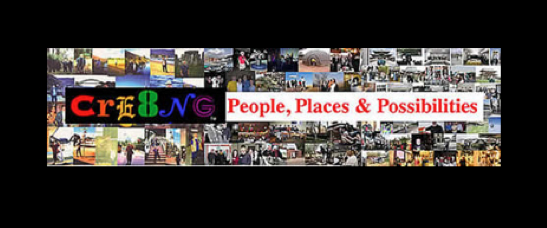
Here are my responses to a few questions in honor of CREATIVITY DAY AND INNOVATION WEEK, April 15 to 21
What will do this year to honor Creativity and Innovation at work, in school, in your life?
http://www.creativityday.org/Welcome.html1. What is a creative environment? How do you define it? What do you need to be at your creative best? How do you/can we develop a creative environment to promote day-to-day creative-thinking and solutions at home, school and in business? (You can refer to physical space, attitudes, systems, beliefs, etc.)
The total environment (physical, visual, audible, social, psychological, attitudinal, systems, beliefs, etc impact people in varying ways.
Some people just having a space to work and problems to work on is enough.
Some need highly stimulus filled spaces and environments.
Some need only to feel part of a group/team/family they trust to be creative
Some need systems to follow, guidelines and realistic parameters to be creative
2. What are the common obstacles and fears people commonly face when called to use their creativity? What solutions do you have?
Fear of failure
Team leaders or department heads that have learned to create a supportive environment where failure is not a threat.
Fear of not having their ideas accepted
A team, department or an entire organization that focuses on developing true connection and support throughout.
Fear of being ridiculed
On-going work to eliminate jealousness, immaturity, shallowness, and other factors that cause people to degrade, put down and negate ideas that are not their own.
Fear of be pushed out as strange, weird, undependable, etc.
An environment that grows to accept all its members
Unfortunately most of these are unrealistic in typical human organizations and cultures. A strong manager/leader/coordinator can work on helping individual highly creative individuals learn to deal with or protect them from these “PEOPLE PROBLEMS”.
3. What strategies are available for people to access their creativity?
Infinite intellectual, emotional, psychological, social strategies that are individually internal to those that are externally used by people.
Learning what type of environment works primarily best for them, for their teams, their departments, their organizations.
Hundreds of mental, visual, audible, gustatory, tactile devices and tools that can open up moods and mindsets to allow creativity to flow.
Tools and processes that people can learn that help them break mindsets, moods, perspectives allowing them to see things more creatively.
4. In what ways are you creative? In what ways do you contribute to the creative process/outcomes for others?
“Let me count the ways.”
Since first becoming aware of the first creative tool I experienced, S.C.A.M.P.E.R. created by Bob Eberle, and then attending my first CPSI and experiencing many creative thinking tools throughout the conference I have been collecting, discovering, creating, teaching/training varieties of SYSTEMS, TOOLS/TECHNIQUES, ATTITUDES/APPROACHES, METHODS, PROCESSES and STRATEGIES that can help people when they need to recharge, respark, regenerate or simply turn on their creativity.
By using a system of methods I continue to discover
S-SUPPORTING
P-PROMOTING
R-RECOGNIZING/REWARDING
E-EDUCATING/ENCOURAGING
A-APPLYING
D-DEVELOPING
Being creative is a choice that each of us can make any time any day. High, breakthrough creativity happens. Yet we can otherwise always choose to be more creative than the conditions and situations at any given moment appear to generate.




